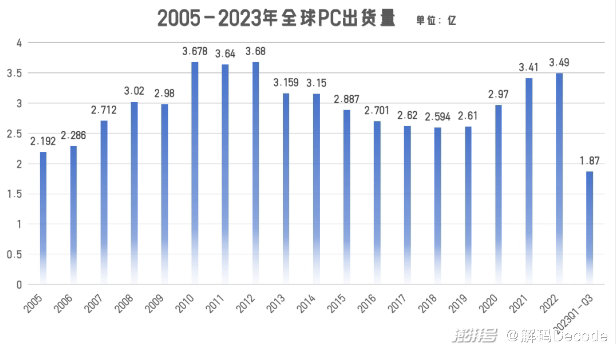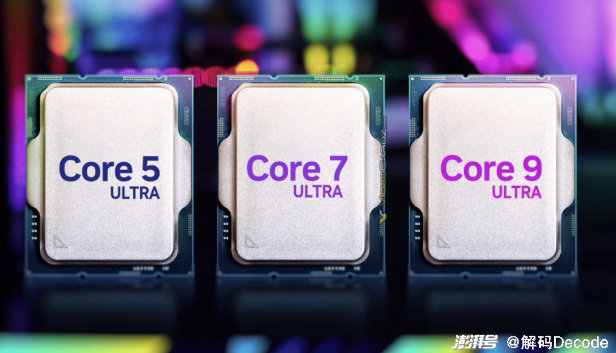Are Lenovo and Intel overly optimistic about AI PCs?
This is the true portrayal of the first generation of Centrino mobile technology: Intel has made wireless network cards a standard configuration, allowing laptops to truly be portable and mobile.
As Intel's slogan goes, 'Wireless is your infinite', laptops have truly ushered in the wireless era. Centrino's mobile technology is not only a technological advancement, but also Intel's interpretation of a new way of work and life for users.
Unfortunately, Intel did not experience the "Swift Moment" in the following twenty years.
However, during this year's Q2 earnings conference call, CEO Pat Gelsinger revealed that the upcoming Meteor Lake 14th generation Core processor would become Intel's next "Swift Moment".
The CEO of Intel's revival of Centrino is clearly not just about reliving the glorious years.
Has another moment for the PC arrived?
Intel, which was eager to make a hot search before the product was released, ultimately suffered from the long-term decline of the PC market.
Since 2011, the PC market has shifted from an incremental market to a stock market, with slow technological development and gradually weak demand. After 2019, due to the increase in demand for online office, a wave of PC shipments rebounded, but once the Black Swan incident passed, the shipment volume suddenly decreased.
In Q1 2022, Lenovo, HP, and Dell still had 18.3 million, 15.8 million, and 13.7 million shipments, while in Q4, there were only 15.5 million, 13.2 million, and 10.8 million left.
Entering 2023, the trend is still rapidly declining. According to IDC, global PC shipments in the first three quarters of this year decreased by 17.1% year-on-year, totaling 187 million units, dropping to the level of 2005.
After more than 30 years of development, PCs have undergone changes in the form of desktops, laptops, and tablets, with penetration rates approaching the ceiling. The entire industry lacks sufficient innovation, and people's demand for traditional PCs comes more from natural replacement cycles.
The latest natural replacement cycle, or the upcoming shutdown of Windows 10 in 2025.
According to information disclosed on Microsoft's official website, Windows 10 will be discontinued on October 14, 2025. At that time, all versions of Windows 10 will be discontinued, and higher level systems require higher configuration computer support, which means that personal computers that only support Windows 10 or lower system configurations will be difficult to apply.
However, Southwest Securities previously predicted in a survey that there will be a PC refresh wave in 2024. The core reason, besides the Windows version update, is that the increase and innovation of AI functionality in personal computers will generate new market demand.
Canalys even predicts that AI compatible personal computers are expected to have a penetration rate of 37% by 2025, with AI compatible personal computers accounting for approximately 60% of all PC shipments by 2027.
So, for Intel and a group of PC manufacturers, AI has become a lifeline.
To this end, Intel has also launched the AI inference and deployment runtime tool suite OpenVINO in addition to the Meteor Lake. This version includes pre trained models optimized for integration across operating systems and various cloud solutions, including multiple generative AI models, such as Meta's Llama 2 model.
Lenovo has launched the AI Twin for both personal and enterprise level artificial intelligence, as well as a hybrid AI framework covering both personal and enterprise level models. And at the 2023 Lenovo Tech World Innovation Technology Conference, it was revealed that a PC product equipped with an end side large model will be launched in September next year, and it will also enter the car end in the future.
PC manufacturers such as Dell, HP, and Acer have also stated that they will launch new AI PC solutions from 2024 to 2025.
The reason why PC manufacturers are so excited is not difficult to guess. Although the peripheral expansion (32GB memory+2TB hard drive) due to AI features can make PC prices more expensive, compared to the historical opportunity to break away from the status of an assembly plant for thousands of years, this amount of money is not much.
More importantly, more personalized, complex/professional application software may become the main force for the growth of the AI PC ecosystem, while single function applications may be replaced by AI assistants that come with AI PCs.
Drawing on the development experience of Tesla FSD and Microsoft 365 Copilot, AI PC terminal manufacturers and their application ecosystem partners are expected to gain more value increment by providing AI services and solutions beyond hardware.
Are you overly optimistic?
In the past few months, several frontline leaders have expressed their optimism towards AI PC, and HP CEO Loures excitedly said, "I have been working in the (PC) industry for decades and have never seen such an opportunity
Lenovo's Yang Yuanqing provided a specific schedule, saying, "Next year we will see AI PCs that can be played offline." Acer Chief Operating Officer Gao Shuguo also eagerly showcased Acer AI notebooks equipped with Core Ultra processors at the Intel ON Technology Innovation Summit last month.
However, some people have expressed a cautious and optimistic attitude. Acer Chairman Chen Junsheng believes that "this is a gradual process, and there will not be AI PCs starting tomorrow. It is a gradual occurrence
Asus CEO Hu Shubin believes that AI PC is expected to gradually mature in the third quarter of next year, and there is also a major premise that the overall economy next year will be better than this year and the year before.
But no one has slowed down their pace as a result. For PC manufacturers, in the context of severe homogenization of traditional PC hardware, their ability to create AI big models, as well as their ability to match the overall design of AI PCs with big models, may be the only correct way to rebuild the competitiveness of PC brands.
Even though PC manufacturers are still more concentrated in the latter half, which is the ability to match the overall design of AI PC with large models.
For example, Lenovo's previously high-profile "AI Twin" was jointly created with Microsoft, and the reason why Lenovo was able to run end-to-end AI was essentially due to Intel's launch of the Meteor Lake.
In other words, whether it's underlying computing chips or upper level software applications, nothing belongs to Lenovo, which is a serious problem facing major PC manufacturers.
For Intel, the risk of being overly optimistic comes from ARM's new challenge to the X86.
Microsoft will integrate the Copilot algorithm into PC hardware in the latest Windows version released in 2024, providing real-time personalized services, including information query and answering, assisting in work file generation, and video entertainment assistants. The appearance of a PC integrated with AI algorithms may not change significantly, but the requirements for hardware specifications will be much higher.
One point points to the computational power of the chip.
Some Taiwanese media have reported that the threshold for computing power for PCs with built-in Copilot is 40TOPS, while Intel's upcoming Core Ultra (Meteor Lake architecture) may not meet this threshold, and it is expected that the next generation Lunar Lake will be able to do so. The Lunar Lake will be manufactured using the 18A process in 2024 and is expected to be launched only in 2025, possibly one year behind other manufacturers' products.
On the other hand, the parameters of the Snapdragon X Elite platform demonstrated by Qualcomm in the ARM architecture camp can meet the above threshold, and AMD's Ryzen 8000 series, which will be launched in 2024, can also meet the standards.
Although Intel has been known for its toothpaste like innovation since the Centrino era in 2003, it has always left AMD behind and prevented the coveted Qualcomm from crossing the high wall. The biggest reliance lies in the fact that in the PC or IT fields, the ultimate market victory is never achieved by the most technologically advanced manufacturers or products, but depends on the overall market ecosystem and partner support.
So the obstacles Qualcomm faces are not only the joint crackdown of Intel and AMD (same architecture vs. different architecture), but also broader ecological barriers.
In 2019, Huawei once launched a MateBook E equipped with Qualcomm processors, but due to issues such as Windows support and software ecology, the response was mediocre. After purchasing Matebook e go 2022, a user discovered that several of Huawei's own services, including computer butlers, are still based on x64 architecture.
For Qualcomm, returning to the PC market brings a relatively advanced product with support and recognition from Microsoft, which can be seen as an improvement. However, whether it can obtain the support of all PC manufacturers remains a major issue.
Because from a global market perspective, the fate of this CPU is fundamentally determined by how many models ODM manufacturers will develop based on Qualcomm's design next year or the following year.
For example, Lenovo is now the world's largest manufacturer of PCs, occupying a large market share. Lenovo may have 200 models in each generation of products in the market, but whether it offers 5 or 150 models to Qualcomm indirectly determines Qualcomm's market fate.
In addition, there have been recent reports that AMD and NVIDIA are both developing client PC processors based on the Arm architecture, further challenging Intel.
Although Patrick Gelsinger stated that "ARM chips, like desktop systems aimed at replacing Windows, have been downgraded to a relatively insignificant role in the PC market. Even if ARM based CPUs succeed, this may still be an opportunity for Intel OEM Services (IFS)
Although Patrick Gelsinger has shown full confidence, the analyst firm Theregister has evaluated this and believes that recent history tells Intel that they should be concerned. Although ARM will not occupy the PC market overnight, calling ARM a "negligible" threat to Intel's PC business is short-sighted.
Epilogue
At present, AI PC is still in the early stage of product development, but a foreseeable trend is that with the development of AI computing power in terminal devices, less complex training tasks will also be migrated to terminals, and AI PC will become the trend of the industry.
The reason is that although AI inference requires low computational resources, it is much larger in overall scale than AI training, and with the increasing scale of applications, relying solely on cloud resources will result in high usage costs. The scale and commercialization of downstream applications of AI large models require the utilization of end-to-end AI processing capabilities, and the increase in the total amount of neural network computing for terminal devices will promote targeted development of hardware architecture.
Although the current AI PC product gimmicks outweigh the actual user experience, Lenovo's terminal display, Intel's AI PC acceleration program, and the deeply bound collaboration ecosystem with numerous ISVs all indicate that the AI upgrade on the terminal side has advantages that the cloud does not have.
The problems facing Intel, PC manufacturers, and even the Wintel alliance are still thorny:
Under the ARM architecture, both Qualcomm and NVIDIA are competitors that Intel cannot underestimate; Microsoft has built-in Copilot in its operating system, and PC manufacturers also need their own big models, otherwise the value increment at the software level cannot be discussed.
In the end, the assembly plant that walks on thin ice the most is the Wannian assembly plant, where chips and systems are still held in the hands of others.
(From Surging news)


